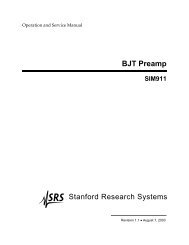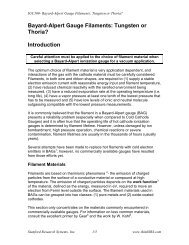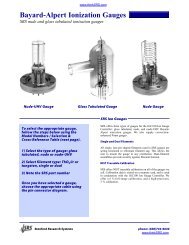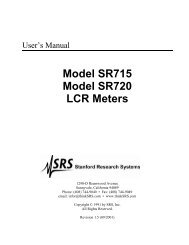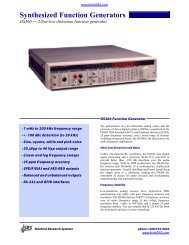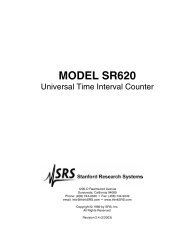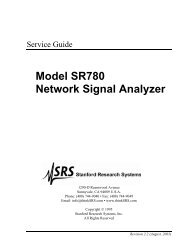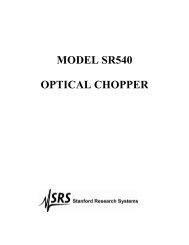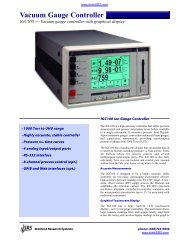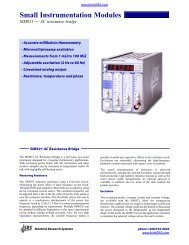Quartz Crystal Microbalance Digital Controller
Quartz Crystal Microbalance Digital Controller
Quartz Crystal Microbalance Digital Controller
- No tags were found...
You also want an ePaper? Increase the reach of your titles
YUMPU automatically turns print PDFs into web optimized ePapers that Google loves.
36 Theory, Operation and Calibration Chapter 2f = frequency change in Hz,M w = apparent molar mass of the depositing species in grams/mole,C f = Sauerbrey’s sensitivity factor for the crystal used (see eqn. 1),Q = integrated charge during the reduction in Coulombs,A = active deposition area of the working (liquid contact) electrode in cm 2 ,F = Faraday’s constant = 9.648 x 10 4 Coulomb/mole,n = number of electrons transferred to induce deposition (i.e. n =1 for Ag deposition).(The factor of 10 6 provides for the unit conversion from µg in C f to g in M w .)A plot of f vs Q will deliver the apparent mass per electron of the deposited species,when n is taken into account. This is often used to elucidate the mass changes thataccompany redox processes, and hence is very useful for characterizing the mechanismsof electron-transfer reactions.However, before any calculations can be performed based on eqn. 17, the EQCM must becalibrated in order to properly derive (1) the proportionality constant, C f , of the Sauerbreyequation in solution and (2) to account for the effective area of the working electrode.This is generally done using a well behaved electrochemical reaction - typicallyelectrodeposition of silver, copper or lead on a Au or Pt electrode.The EQCM calibration method favored by Stanford Research Systems for its QCM200System is based on the galvanostatic deposition of Ag. A 50 mM solution of AgNO 3 in0.5 M HNO 3 is subjected to a reducing potential and Ag is deposited with a fixedcathodic current density of 50-500 µA/cm 2 . The cathodic current is integrated to obtainthe charge as a function of time. Excellent linearity is generally observed in f vs Q plotsfor depositions within 1 µg/cm 2 , providing a very reliable way to calibrate theproportionality constant of eqn. 17.Several calibration procedures are also described in the electrochemistry literature 28 , andusers are referred to the publications list at the end of this chapter for details.Polymer Modified ElectrodesThe EQCM has been extensively used to study polymer modified electrodes, particularlyas a gravimetric tool to follow redox processes 29 . However, for the linear frequency-tomassrelationship (described by eqn. 17) to hold true, the polymer overlayer must exhibitno changes in rigidity during the electrochemical process. Otherwise, the viscoelasticchanges will also contribute to the frequency change, leading to an erroneousinterpretation of the mass changes 30 . As a consequence, it is essential to determinewhether or not viscoelastic properties of the polymer film influence the frequencymeasurement during polymer film experiments!QCM200 <strong>Quartz</strong> <strong>Crystal</strong> <strong>Microbalance</strong>



